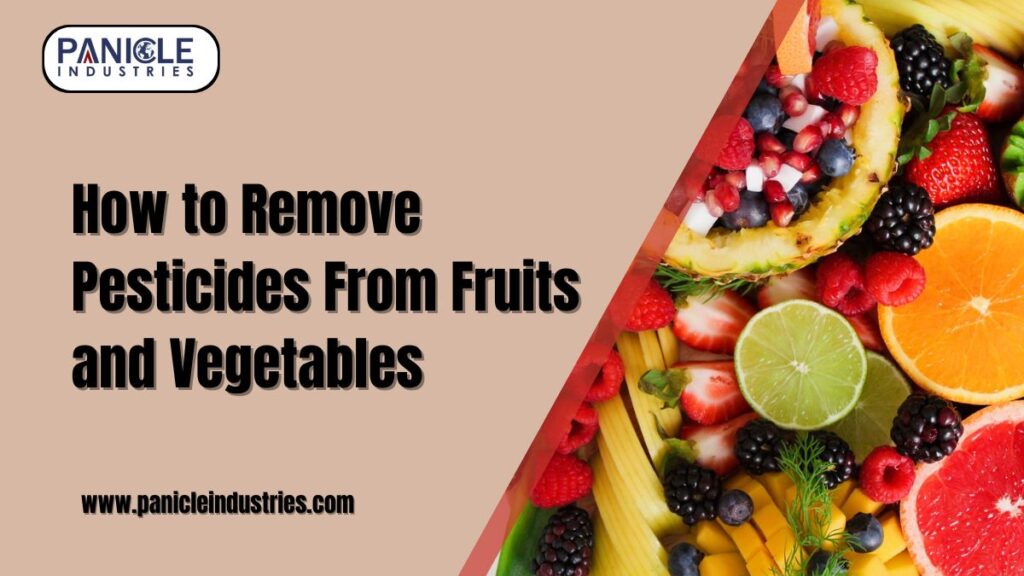Fruits and vegetables are an essential part of a healthy diet. They provide us with important vitamins, minerals, and fiber that help our bodies function properly. However, many fruits and vegetables contain pesticides. Farmers use pesticides to protect crops from insects, fungi, and diseases. While these chemicals help produce better yields, they can be harmful to human health if consumed in large amounts. That’s why it is important to wash and clean fruits and vegetables properly before eating them.
In this blog, we will discuss how to remove pesticides from fruits and vegetables using simple and effective methods that ensure your food is safe and healthy.
How to Remove Pesticides From Fruits and Vegetables
1. Wash with Running Water
One of the easiest and most effective ways to remove pesticides from fruits and vegetables is to wash them under running water. Hold the produce under the tap and gently rub the surface with your hands. This method works well for most fruits and vegetables, such as apples, tomatoes, cucumbers, and carrots. For leafy greens like spinach and lettuce, separate the leaves and rinse them thoroughly. Running water helps remove dirt, bacteria, and some pesticide residues. It is a simple and quick step that everyone should follow before eating or cooking fresh produce.
2. Soak in Salt Water
A salt water solution is an excellent way to reduce pesticide residues on fruits and vegetables. Mix one tablespoon of salt in a bowl of water and soak the produce for about 10 to 15 minutes. Salt helps break down chemical residues and removes dirt effectively. After soaking, rinse the produce under fresh water to remove any remaining salt. This method is particularly useful for fruits like apples, grapes, and berries, as well as vegetables like bell peppers and potatoes.
3. Use Baking Soda Solution
Baking soda is a natural cleaning agent that can help remove pesticides from fruits and vegetables. To use this method, fill a bowl with water and add one teaspoon of baking soda. Soak the produce for about 15 minutes. Baking soda helps break down pesticide residues, making it a safe and effective way to clean your food. After soaking, rinse the produce with clean water before consuming. Studies have shown that baking soda is effective in removing certain pesticides from fruits like apples and grapes.
4. Vinegar Wash
Vinegar is another great natural ingredient that helps remove pesticides. Mix one part vinegar with three parts water in a bowl. Soak the fruits and vegetables in this solution for 15 to 20 minutes. Vinegar helps kill bacteria and break down chemical residues. After soaking, rinse the produce with fresh water to remove the vinegar taste. This method works well for a variety of fruits and vegetables, including leafy greens, apples, and cucumbers. However, it is not recommended for delicate fruits like berries, as they may absorb the vinegar and change their taste.
5. Peel the Skin
Many fruits and vegetables, such as apples, potatoes, carrots, and cucumbers, have pesticide residues on their outer skin. One of the simplest ways to remove these chemicals is to peel the skin before eating or cooking. While peeling removes some nutrients present in the skin, it also helps reduce pesticide exposure. Make sure to wash your hands and knife properly before and after peeling to avoid contamination.
| Eating clean starts with fresh, pesticide-free food. Just like washing fruits and veggies is important, choosing pure, high-quality rice matters too! At PanicleIndustries, we offer the best Basmati and Non-Basmati rice for a healthy meal. |
6. Use Lemon Juice
Lemon juice is a natural acid that can help break down pesticides on the surface of fruits and vegetables. Mix one tablespoon of lemon juice with a bowl of water and soak the produce for about 10 minutes. The acidity of lemon juice helps neutralize harmful chemicals. After soaking, rinse the fruits and vegetables with fresh water to remove any lemon residue. This method is especially useful for cleaning grapes, berries, and apples.
7. Blanching
Blanching is a method where vegetables are briefly boiled in hot water and then cooled in ice water. This process can help remove pesticides from produce like spinach, beans, and cauliflower. Boiling helps dissolve pesticide residues, making the food safer to eat. However, blanching may also reduce some nutrients, so it should be used only when necessary.
8. Use Commercial Fruit and Vegetable Wash
There are several commercial fruit and vegetable washes available in the market that claim to remove pesticides and bacteria. These washes are made from natural ingredients like citrus extracts and baking soda. To use them, follow the instructions on the packaging. Most of these washes require you to soak or spray the produce and then rinse with water. While commercial washes can be effective, they are not always necessary if you follow other natural cleaning methods.
9. Scrub with a Brush
For fruits and vegetables with thick skins, such as potatoes, carrots, and cucumbers, using a brush can help remove pesticide residues. A vegetable brush can be used to scrub the surface under running water. This method works well for root vegetables and hard-skinned fruits. Make sure to clean the brush regularly to avoid transferring dirt and bacteria to other produce.
10. Buy Organic Produce
One of the best ways to reduce pesticide exposure is to buy organic fruits and vegetables. Organic farming uses natural methods to protect crops, avoiding synthetic pesticides and harmful chemicals. While organic produce may still have some natural pesticide residues, they are generally safer than conventionally grown produce. If organic options are available and within your budget, they are a healthier choice for you and your family.
11. Dry Properly After Washing
After washing or soaking, make sure to dry the fruits and vegetables properly before storing them. Use a clean cloth or paper towel to remove excess moisture. This step helps prevent bacterial growth and keeps the produce fresh for longer. Drying is especially important for leafy greens, berries, and other delicate fruits.
Conclusion
Eating fresh fruits and vegetables is essential for a healthy life, but it is equally important to make sure they are clean and free from harmful pesticides. In this blog, we discussed how to remove pesticides from fruits and vegetables using simple and effective methods. Washing with running water, soaking in salt water, using baking soda or vinegar, and peeling the skin are all great ways to ensure food safety. Other methods like blanching, scrubbing with a brush, and using commercial washes also help reduce pesticide residues.
Whenever possible, choose organic produce for a healthier option. By following these steps, you can enjoy your fruits and vegetables without worrying about harmful chemicals. Stay healthy and eat safe!


